Post by 90GTVert on Mar 14, 2011 10:01:14 GMT -5
Take Along Tool Kit
No one enjoys breaking down and being stuck on the side of the road. A tow home can be expensive. It's often a long wait for a ride or help, especially if you are far from home. Sometimes you have to be somewhere and a breakdown can really ruin your day. Regardless of the cause or effect, it's no fun. Don't assume it won't happen to you. Even the best maintained and highest quality vehicles falter at times. The good news is, you can save yourself a lot of time waiting around or walking if you are prepared.
The purpose of this article is to go over some of the items that are good to carry along on your scoot, but perhaps the most important tool you can possess is knowledge. All the tools in the world can't help you if you have no idea how your scooter works or how to do at least basic troubleshooting and repairs. For that reason, I strongly advise spending some time getting acquainted with your scooter in the operation of your scooter's critical components.
Look it over. Find out where everything is in the comfort of your driveway or garage and with adequate lighting rather than on the side of a busy road at night. Identify the locations of critical components such as the battery, coil, CDI, and rectifier/regulator. Most crucial components are on the engine, so if you can find that you can find them. Those electrical bits can be remotely mounted nearly anywhere on a scoot. It's also a good idea to learn the easiest way to access bulbs in case they need to be replaced. Look around the forum or do Google searches to find reading material related to engines and troubleshooting that may help you along the way. The Tech Library of this forum includes some good articles that you may find quite useful.
Do at least routine maintenance yourself as a learning experience. Change your own spark plug. Change your own engine oil and gear oil. Adjust your carburetor. Change your own belt or tune your own transmission. All of this experience can be priceless if you ever breakdown. With all of that said, now we can start talking tools.
A good tool kit starts with the most basic hand tools. A screwdriver or screwdrivers for flat and phillips head fasteners, a ratchet/socket set, and wrenches or an adjustable wrench. You can buy these separately, but Home Depot carries a tool set made by Husky that is great for a travel kit. It only costs $15 at the time of this article and it includes a lot. There are a lot of cheap tool kits out there, but this one seems to be of better quality than some I've seen, and the stubby tools will save valuable space.
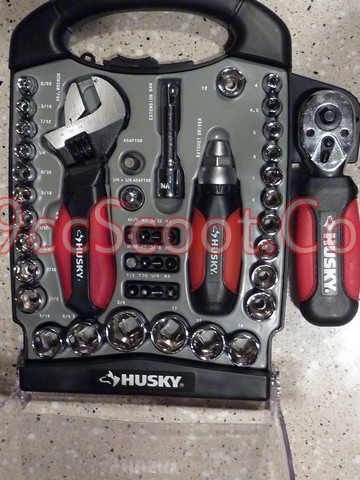
Here's a list of what this Husky 45 piece stubby tool set includes :
- Stubby 3/8" And 1/4" Drive Ratchet (3/8 on one side, 1/4 on the other)
- 3/8" to 2/4" Drive Adapter
- Short 3/8" Drive Extension
- Metric 1/4" Drive Sockets : 4mm, 4.5mm, 5mm, 6mm, 7mm, 8mm, 9mm, 10mm, 11mm, 12mm, 13mm
- Metric 3/8" Drive Sockets : 14mm, 15mm, 17mm
- Standard 1/4" Drive Sockets : 5/32", 3/16", 7/32", 1/4", 9/32", 5/16", 11/32", 3/8", 7/16", 1/2"
- Standard 3/8" Drive Sockets : 9/16", 5/8", 3/4"
- Stubby Adjustable Wrench
- Stubby Ratcheting Driver w/Interchangeable Bits
- Driver To 1/4" Drive Socket Adapter
- Driver Bits : 2x #1 Phillips, 2x #2 Phillips, #3 Phillips, 5/32" Flat, 3/16" Flat, 1/4" Flat, T15 Torx, T20 Torx, 1/8" Hex, 1/4" Hex
I remove the tools from this case and add them into my tool bag, which I'll show later, to save some space.
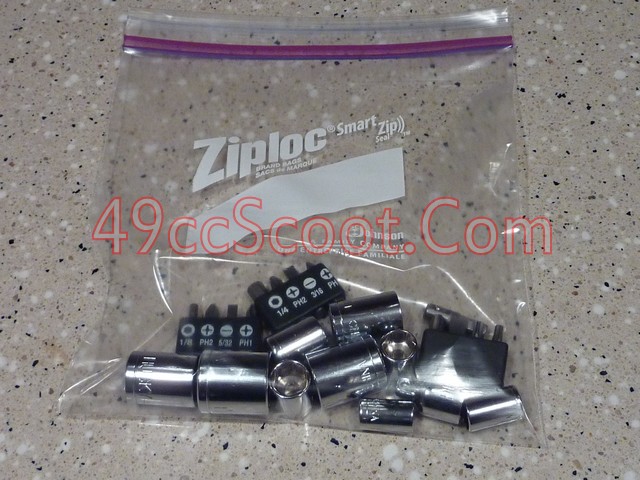
I leave the standard sockets home, other than 5/8" and 3/4". 5/8" may be able to be used as a 16mm socket and 3/4" may be able to be used for a 19mm socket. Both are uncommon on scoots. It doesn't take much more room to carry the standard sockets though, if you would prefer to. I put all of my sockets and bits into a ZipLoc bag to keep them together and easier to find.
I picked up this stubby 8oz ball peen hammer from Harbor Freight for about $3. You never know what you may need to get into on the side of the road, and it doesn't take up much room. I also bought it to help make up for the reduced leverage of the stubby ratchet or wrench if necessary. Sometimes a good tap can help to break free a stubborn nut or bolt.
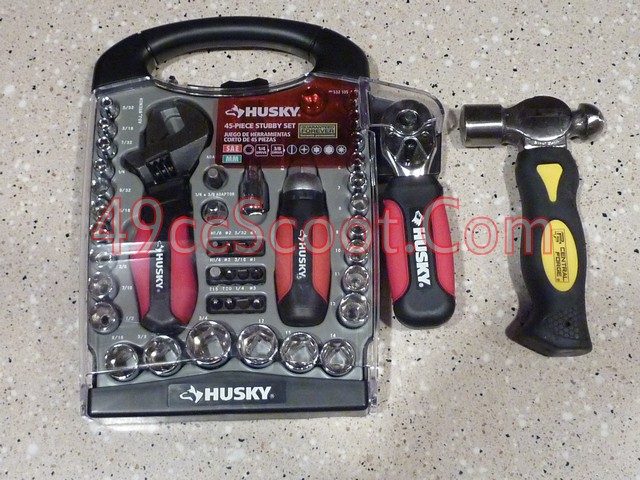
In addition to the adjustable wrench, I also opted to carry along a few additional metric wrenches. Sometimes it's just easier to use the proper wrench, and they cost me nothing. You can pick up cheap wrench sets at Harbor Freight, Northern Tool, Wal-Mart, eBay, or other suppliers. One of my past Chinese made bikes came with these wrenches that cover 7mm, 8mm, 9mm, 10mm, 12mm, 13mm, 14mm, 15mm, 17mm, and 19mm.
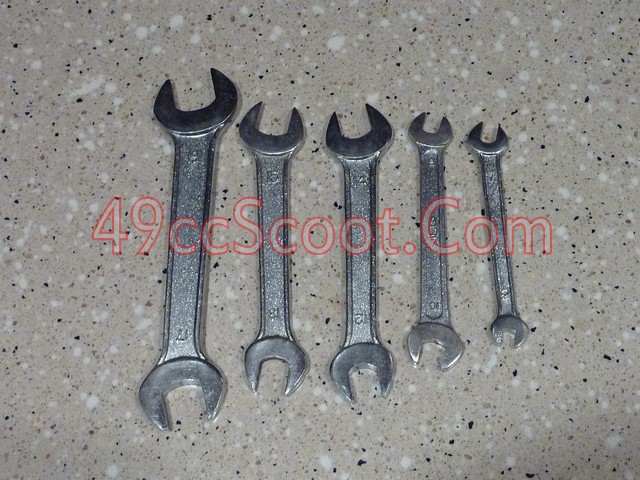
Even though I already have a screwdriver in my tool kit, I also carry along this small, thin, flat screwdriver. It makes carburetor adjustments easier than larger screwdrivers. I got this one for free from a Snap-On tool guy, but if you can't get a free one from your tool man you can pick something similar up very cheap.
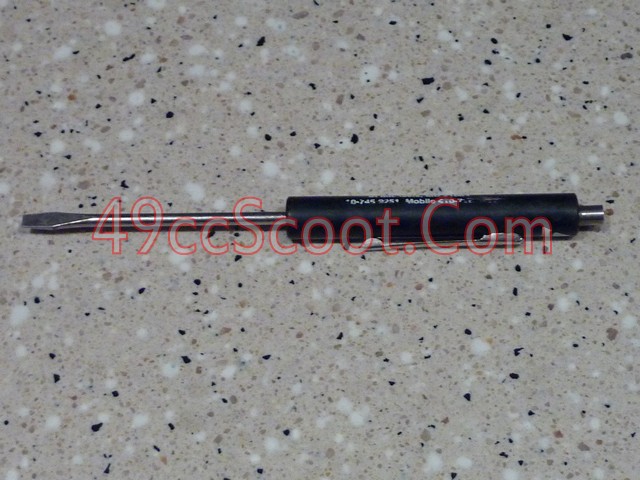
Here you see the small selection of plier type tools that I carry. The left is a pair of stripper/crimpers. This can come in handy if you have any sort of electrical issue on the road. The center is a pair of needle nose pliers with a wire cutter. Needle nose pliers can get to those hard to reach bits, and the addition of a cutter makes them that much more essential. To the right is a pair of vise grips. The vise grips can be used like regular pliers, but they can also lock on to help you extract a broken bolt or anything else that will fit in it's jaws and is a little stubborn. All of these can be purchased very cheap from a discount tool supplier. The crimpers and needle nose pliers are old spares that I had around. I purchased the vice grips at Harbor Freight for $4.
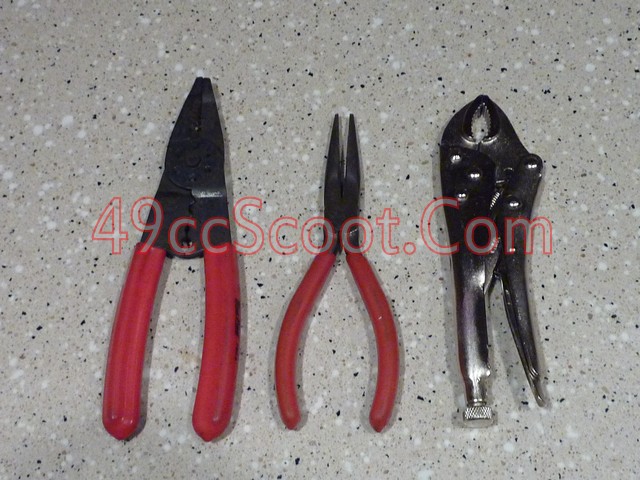
A spark plug socket that fits your scooter and the ratchet you carry is another must-have item in a carry along tool kit in my opinion. Here you see two sizes. The left is a 13/16" spark plug socket that will fit my minarelli/jog style two-stroke scooters. The right is a 5/8" that fits GY6 powered four-strokes since I sometimes ride with a friend that has a GY6. It never hurts to be prepared to help a riding buddy either. I'm not sure what sizes all scooters use, but just make sure you have one that fits your spark plug. I had these around as spares, but you can pick them up for about $3 each at Harbor Freight and other retailers carry them reasonably priced as well.
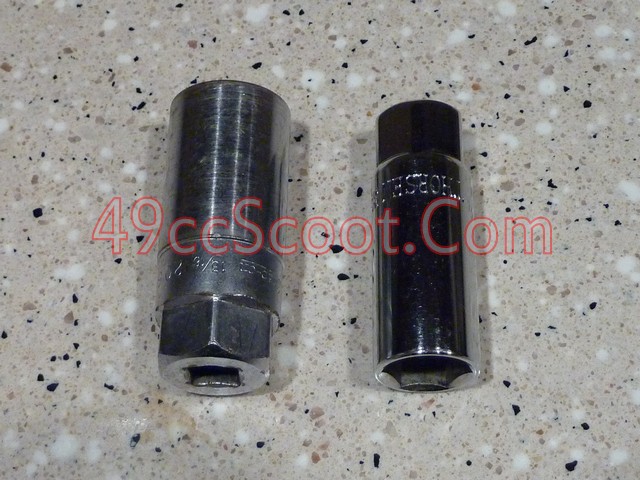
Some scooters use metric hex or allen headed bolts as fasteners for certain things. For example, one of my scooters uses allen bolts for the CVT cover, handlebar riser, intake assembly, and probably other things I'm forgetting right now. If your scooter uses this style of fastener, be sure to carry a socket, foldable set, or individual allen wrenches to match. I had a couple of spare individual wrenches around, but these can be acquired very cheap from the sellers I've mentioned at other times in this article.
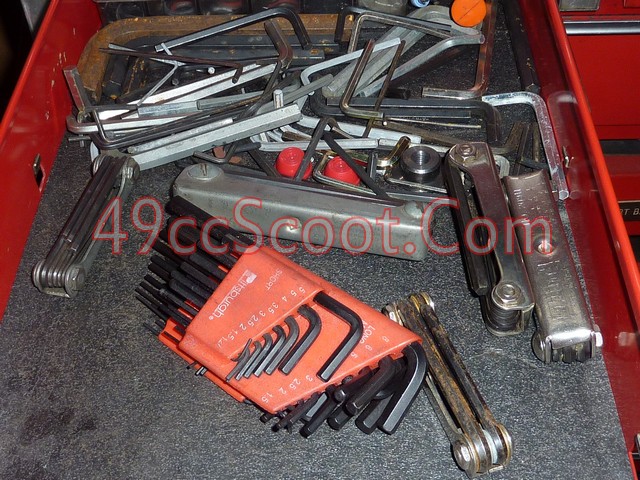
One of the basic tools you absolutely can't leave out is a flashlight. I like to carry spare batteries as well. Even if you don't ride at night, it's a good thing to have. These small LED flashlights can be very bright and don't take up much space. This one was about $10 at a local hardware store and is incredibly bright for it's size. You can get cheap ones for $3-4 from Harbor Freight, though from my experience they aren't quite as powerful.
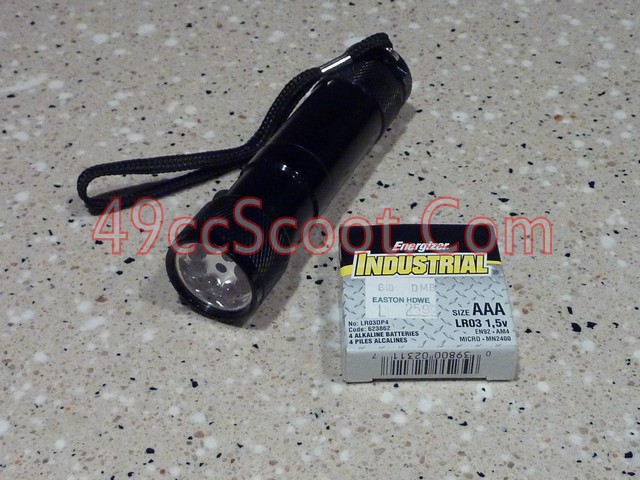
If you want to be prepared for a transmission problem, like a belt issue that can be fairly common, you'll need to be able to remove the variator. I believe it is possible to replace a belt on some scoots without removing either pulley, but unless you know that's the case you'll need a specialty tool. The variator/crank needs to be held stationary so you can remove the variator nut. This first tool is used to lock the variator into place on the 1E40QMB/Minarelli/Jog style engines. You can pick one of these up for around $20 from Enviromoto or other retailers. More info on it's use HERE.
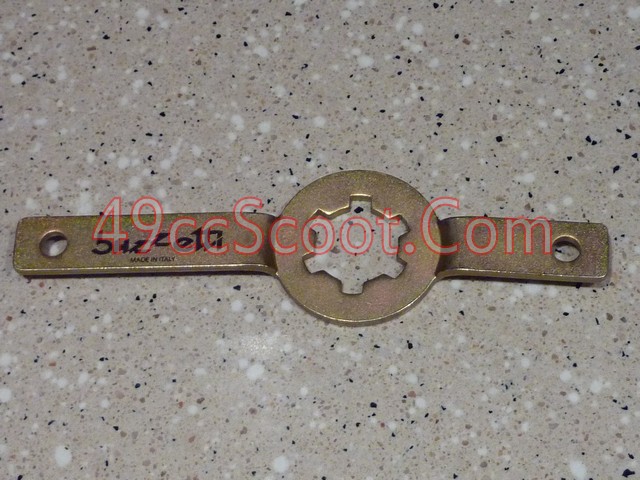
This tool is also available at Enviromoto and other sellers for a similar price. It is used to lock the variator in place on the 139QMB/GY6 50 scoots. (More info.)
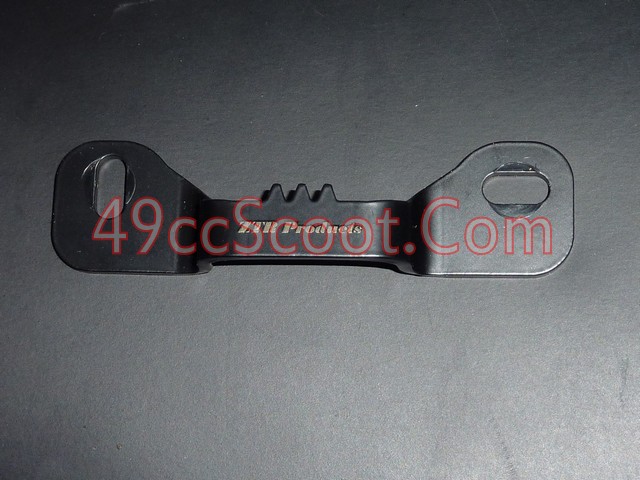
This tool can be used on most scoots. On the GY6 150 powered scoots, the tabs will fit right into holes that are on most of their variators. On other scoots, you can use this to hold the flywheel on the opposite side of the crank in place so you can remove the variator nut. I picked this one up on eBay for less than $20. Some folks make their own version of this tool using flat steel bar.
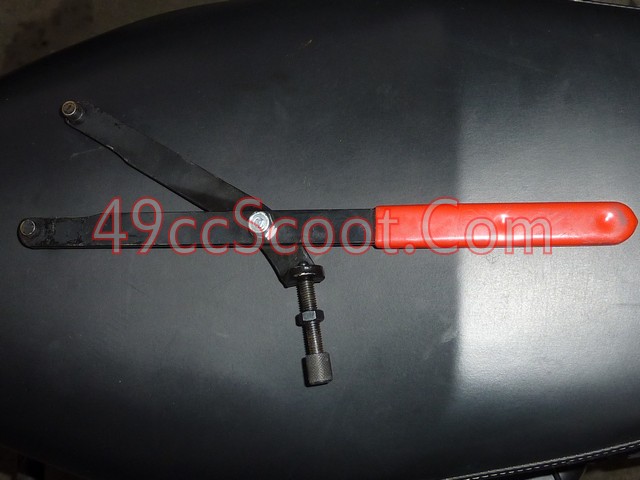
Cable ties/zip ties don't take up much room and they could help you hold on a busted panel or part or a dangling wire or who knows what other use you might find for them. They don't take up much storage space and you can pick up a pack of them very cheap from a lot of stores.
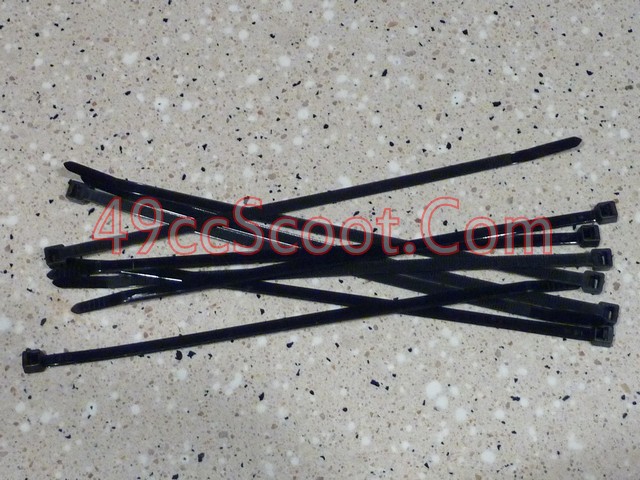
Electrical tape and duct tape could come in handy for electrical repairs or emergency situations. I'm not a big fan of duct tape as some seem to be, but I must admit it could be helpful in certain roadside emergencies.
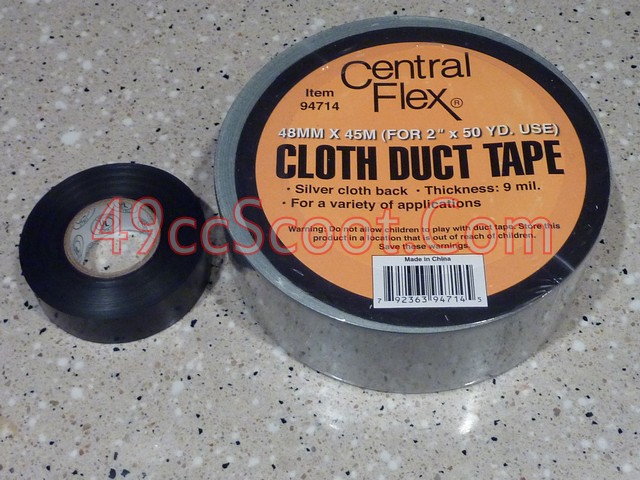
Latex gloves and rags are a must have in any emergency tool kit. You can use the rags to wrap up a part or a few of them to pick up something that's too hot to handle otherwise. Of course they can be used to clean up. Now, you might think the latex gloves are for sissies. You don't mind getting your hands dirty you're thinking... but do you really want to put those greasy hands into an expensive set of riding gloves when you're done working? Probably not. You can get both of these supplies reasonably priced at Harbor Freight and other retailers.

Tire punctures are fairly common on two-wheelers, so it could pay to carry along the tools necessary to plug a tire and get you home. I picked up this tire plug kit from Harbor Freight for $4. It can repair screw, nail, and other small punctures. Once you remove the item that caused your grief, you use the reamer to clean the hole. Then you use the other tool to insert a plug, coated in rubber cement. The razor is to trim off the excess. There are lots of videos on YouTube showing the process. I suggest watching one to familiarize yourself with the idea so you won't have to waste time figuring it out with traffic whizzing by.
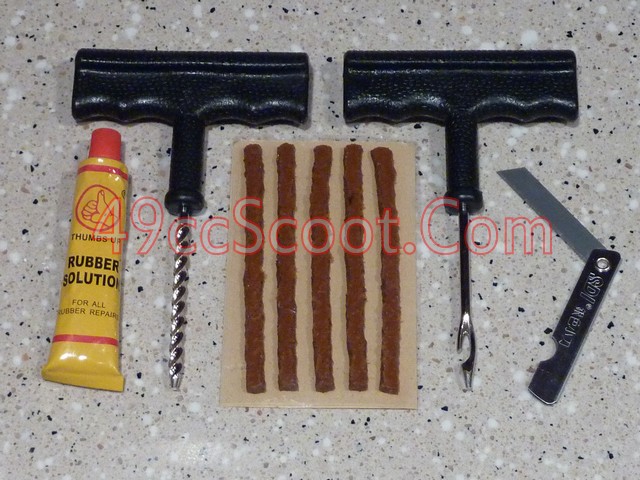
Most likely your tire will lose pressure during the repair process, so you need a way to pump it back up. There are CO2 kits available and some like cans of fix a flat or other products. I picked up this portable 12V air compressor for $7 from Harbor Freight. It comes with a cigarette lighter adapter, but you could make replace that with clips to secure it to your battery terminals or quick connects normally used for a battery charger.
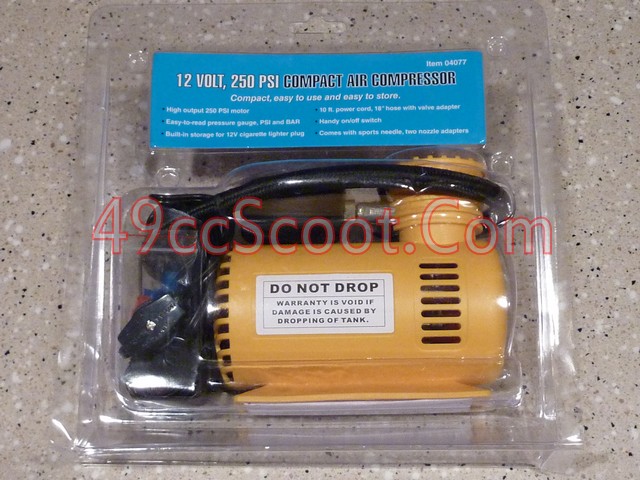
The gauge isn't very precise for the pressures involved, but you don't need to be spot on, you just need to get home without damaging a wheel.
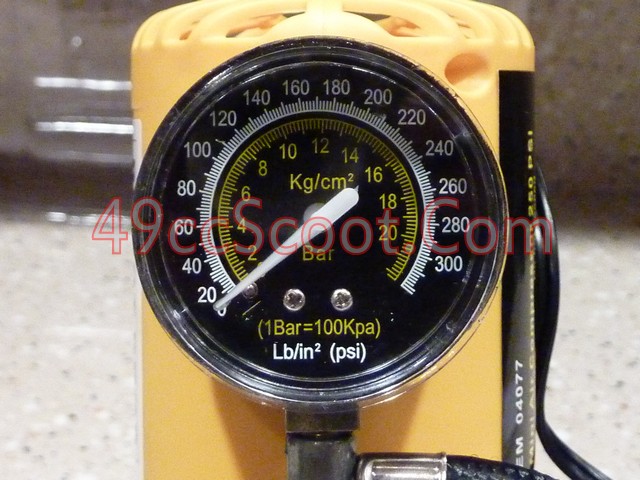
Some folks like to remove the actual pump from it's shell to save more room. I chose to leave mine alone as it fits inside the tool bag I have anyway and the casing protects you from the heat of the pump as well as moving parts. Stepthrutuner shows his solution for guarding the moving pump gear HERE.
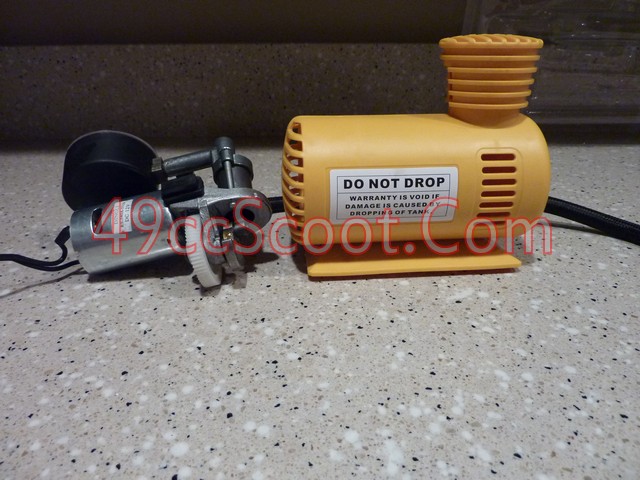
It's very easily removed from it's shell. Just a few screws and you can split it apart.
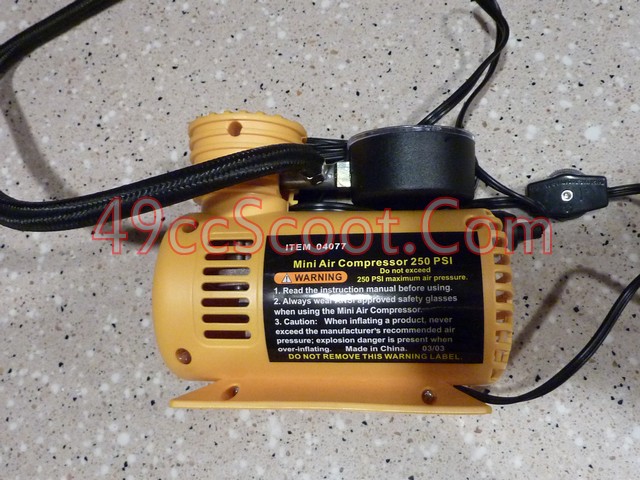
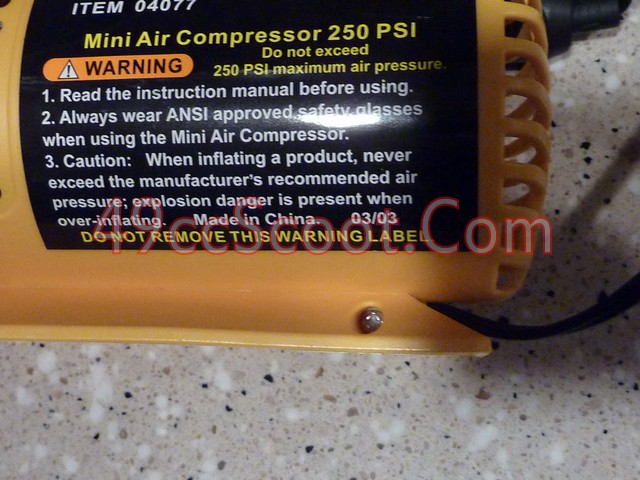
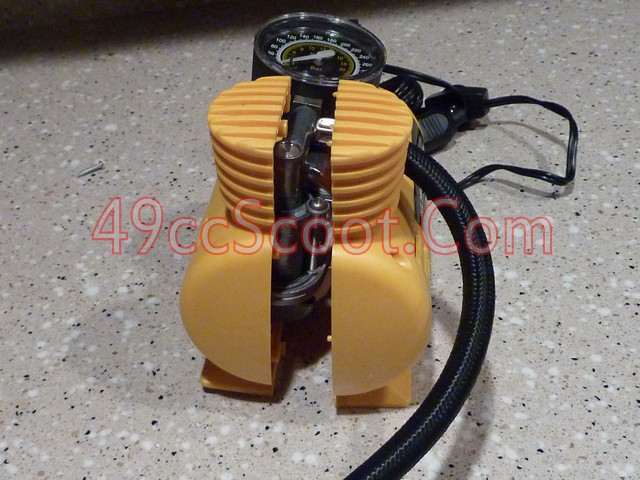
It's a good idea to have a carrying case or toolbox of some sort, rather than tossing this under the seat. A dedicated carrying solution is especially nice if you own multiple scoots so you can transfer your tools from scoot to scoot quickly. I chose this 11" tool bag from Harbor Freight for $6. They have larger versions that are reasonably priced as well, but this one is a good fit in any of my scooters.
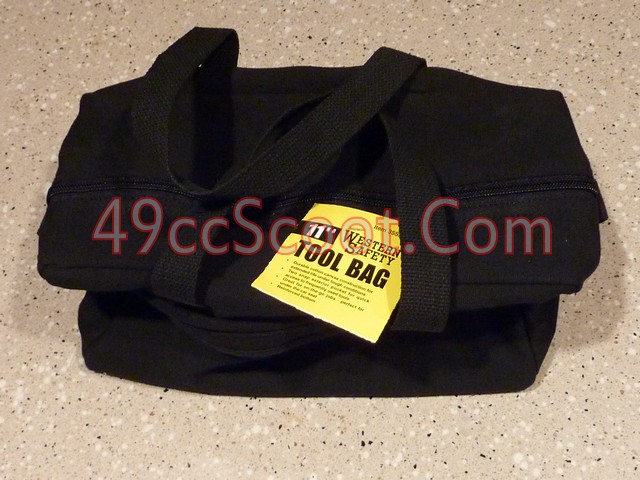
I managed to fit all of the tools I'm carrying, other than the duct tape, into this small tool bag.
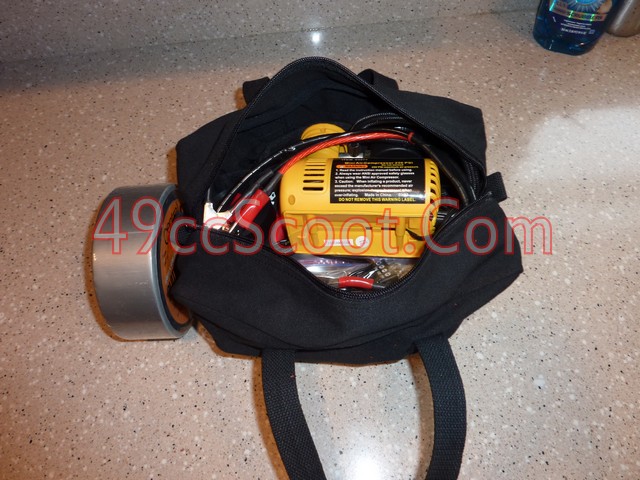
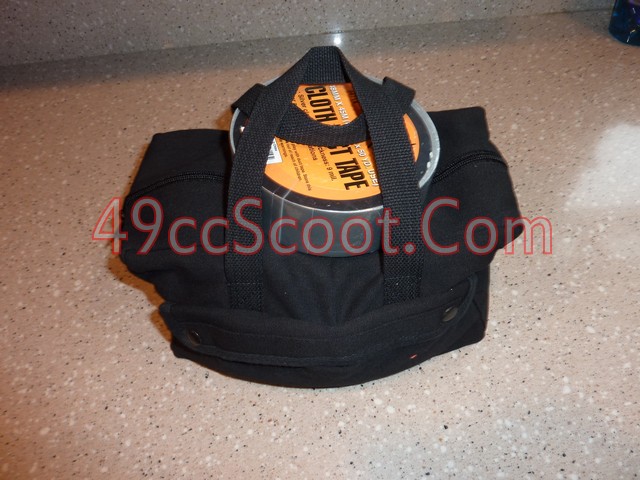
It fits well in even my smallest underseat storage area (Keeway Venus).
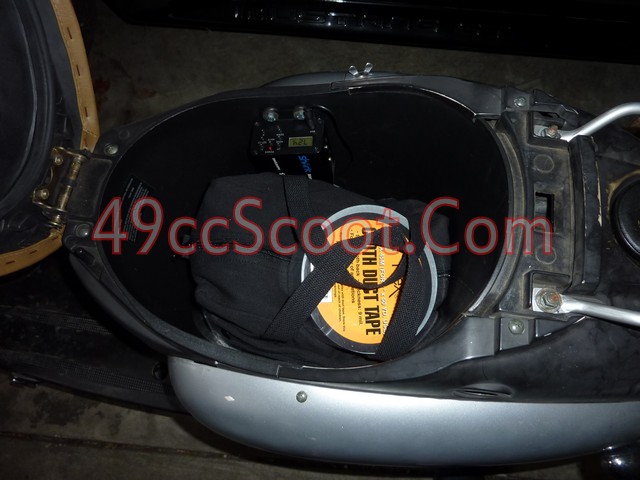
It could also be put into a grocery bag like this one and carried elsewhere on your scoot (as shown here), or you could strap the tool bag to a luggage rack.

I picked up a small storage box from Harbor Freight for a few dollars that fits very well into the bottom of the tool bag I chose. Wal-Mart is another great cheap source for these little containers (check in hardware as well as around fishing tackle boxes).
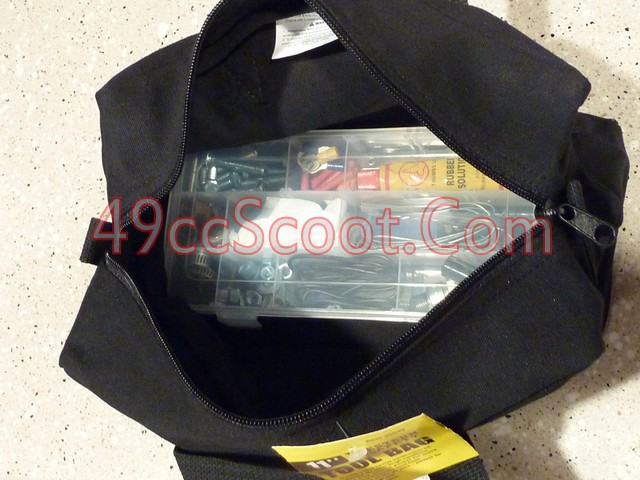
I use the storage bins for all sorts of supplies that may come in handy on the roadside.
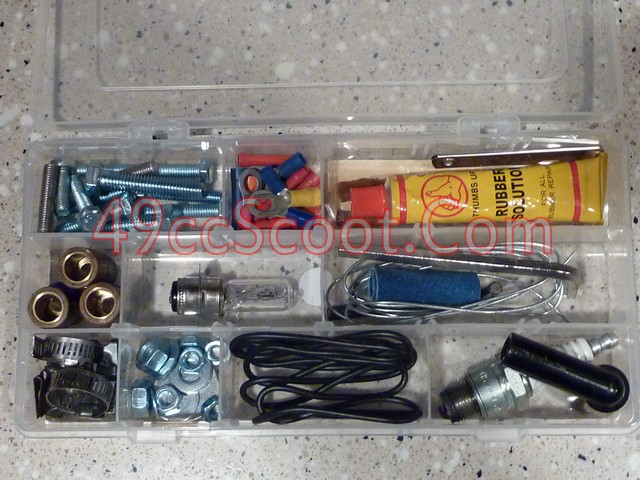
Here's a list of what I carry along in this case, working from L to R, top to bottom :
- A small assortment of bolts that fit my scoot, including exhaust studs. M6 x 1.0 bolts are the most commonly used fasteners on small Chinese scoots. I also carry a couple of M8 x 1.25.
- Electrical connectors. I like to have a few assorted electrical connectors around just in case.
- Tire plug supplies. I carry a couple of plugs, the rubber cement, and the razor from the tire plug kit mentioned earlier in this container.
- A set of roller weights. It's not uncommon for roller weights to be damaged in a belt issue or other transmission issue and it doesn't take much room to carry an old spare set in case of emergency.
- Replacement bulbs. Shown is a replacement headlight bulb. It's not a bad idea to carry an extra tail/brake and turn signal lamp either. I suggest wrapping them in a paper towel to keep them from being damaged.
- Emery cloth, mechanic's wire, and the afore mentioned allen wrenches. Emery cloth can be used to clean up a dirty or damaged part. The mechanics wire could help you secure something or be used to fish a wire through or lots of other random uses.
- Hose clamps, screws, and panel clips. You never know when you might have a fuel line come loose. Always a good idea to have a couple of spare screws and panel clips around.
- An assortment of nuts and washers. Nuts to fit the bolts mentioned earlier as well as the exhaust studs. Washers also matching those sizes.
- Wire. Just plain old electrical wire, I think this is 16AWG. Can be used for electrical repairs or possibly testing.
- Spark plug and spark plug boot. You never know when a plug could foul or a spark plug boot could get loose and cause a miss. They're easy to replace items that also take up very little space.
WT100 had the idea to carry along a set of scooter jumper cables. He made his form an old extension cord and some alligator clips.
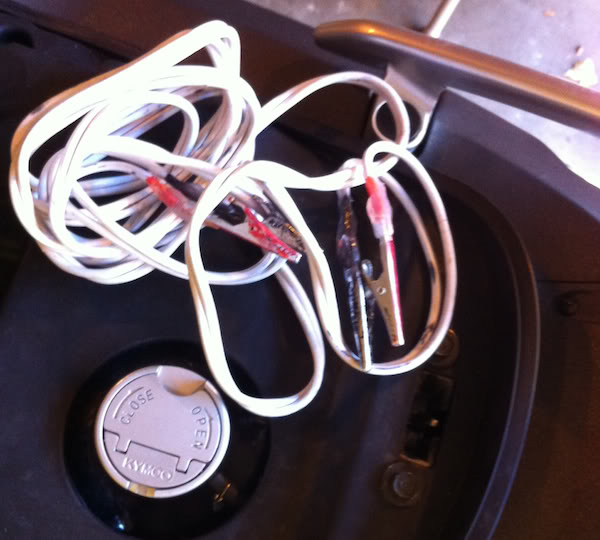
I didn't have an old extension cord that I could spare, but I did have some 10AWG power cable around. I only had 3ft, which should reach from battery to battery on most scoots with the battery in the floorboard. Making longer cables might be a better idea though.
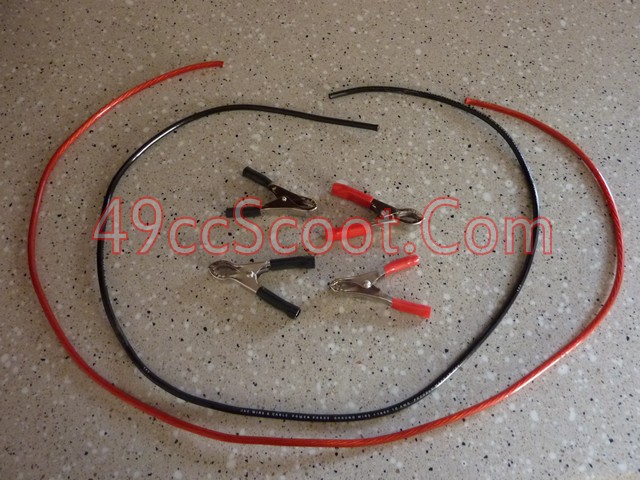
I got the clip on ends from Harbor Freight for a few bucks.
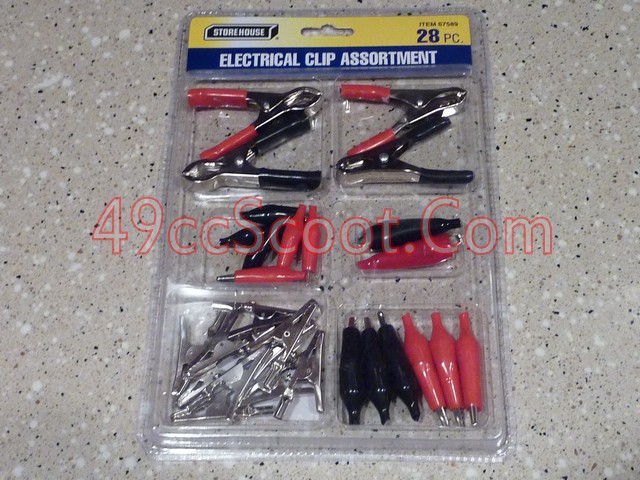
The large clips in the kit let you crimp in the wires. The 10AWG was a little big in the bottom pic, but there is lots of wire crimped in below what you see.
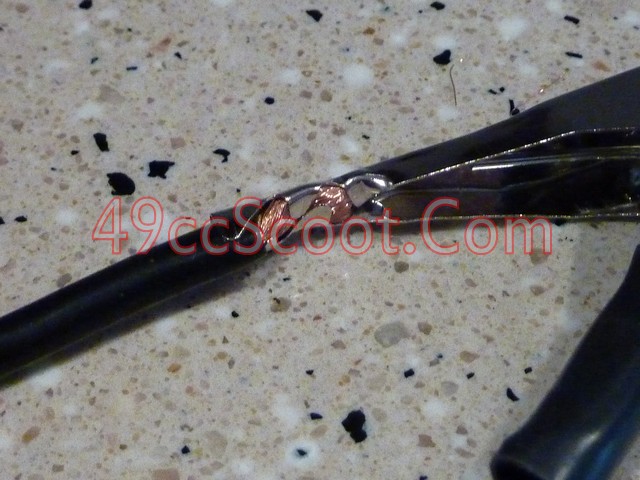
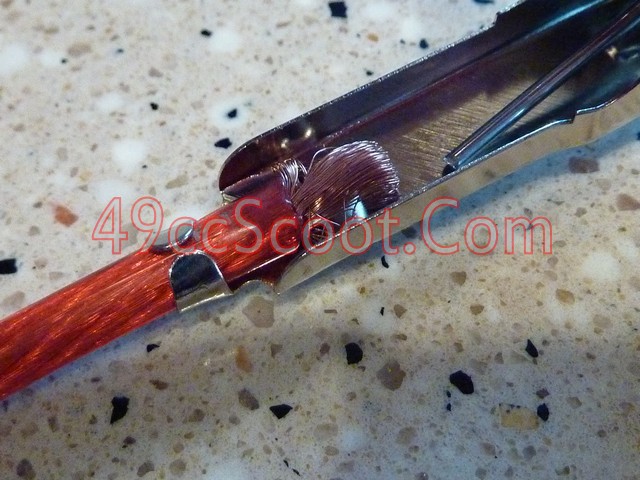
Here's the finished product.
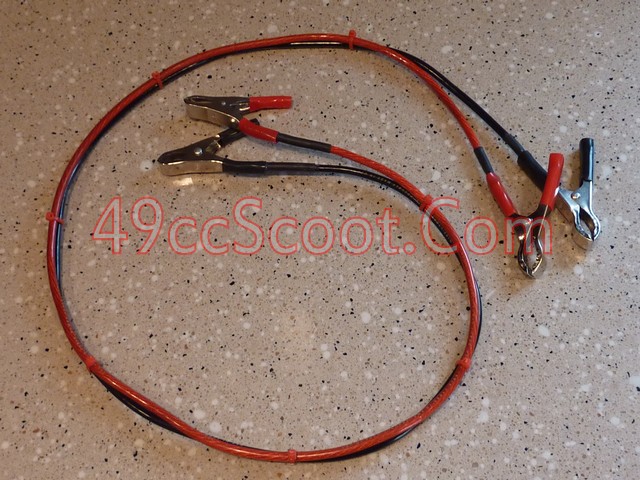
So there's my take along tool kit and a few supplies. The whole deal weighs less than 10lbs. There are some parts that you may want to carry along that haven't been mentioned as well.
A spare belt. Carrying the tools to replace a CVT belt won't do you any good if you don't have a belt to fit. Even if it's a used belt, just carry something that could get you home.
Spare ignition components. I've already mentioned the spark plug and plug boot. A CDI swap is usually pretty simple and could solve an ignition issue. You could also carry along a coil or even a stator if you so choose. Just depends how much space you want to take up and how prepared you wanna be. If you carry a stator, don't forget a flywheel puller.
Oil. It's never a bad idea to carry a quart of engine oil for your four stroke in case of emergency. A two stroke owner should always have oil with him or her for pre-mixing or filling the reservoir if it gets low. I suggest putting the oil container in a bag or container that can be sealed to avoid a potential mess.

